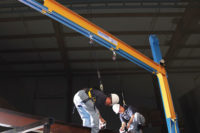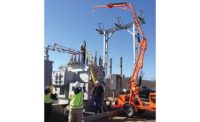
Risks from falls surround us. When you think about it, so much work is done off the ground — on ladders, stairs, silos, scaffolds, towers, poles, aerial platforms and other lift devices. In some industries, like construction, falls make up a large portion of serious injuries and fatalities.
Still, the risks are so familiar in some cases we take them for granted. We’ve all seen ladders used dangerously. So how can we cast the need for fall protection in a new light? Let’s take a psychological perspective.
How do your workers view risks from falls? How do they think about the "good or bad" things that might happen to them while working from heights? Research relating to risk perception and falls is limited, but I came up with five dimensions and a course of action that I believe you’ll find beneficial to your fall protection efforts.
Environmental cues
When steps are taken to ensure that an elevated work environment is a safe one, your employees are apt to take risks from falls, and their own safety, more to heart. They will work within the limits of their own abilities and take fewer chances.
The key is for management to set a visible standard of concern by providing appropriate engineering controls and fall protection equipment. Workers take their cue from actions, not words. You want to send a strong signal that taking risks is not required. Remember, your employees’ beliefs about safety are shaped by the precautions they see being taken. This is particularly important when working from heights.
Prior catastrophes
Sadly, your employees’ respect for working from heights can also be shaped by tragedy. Not surprisingly, workers directly or indirectly involved in a catastrophe are more ready and willing to work safely. Catastrophes such as falls can create an intense emotional response that allows people to see the dangerous realities of working at heights. Vivid memories reinforce the value of safety and induce workers to change their behaviors accordingly.Perceived control
Make sure you give your employees the tools they need to work safely from heights — training, fall protection equipment, job safety analyses, safety procedures, etc. This is how you give employees confidence that they control their own safety.
This belief is critical to protect against falls. When someone believes in his ability to control positive outcomes related to working at heights, he’s more likely to work confidently — and safely. A worker may more readily understand the importance of following procedures and limit individual risk-taking because he knows he is creating his own safe outcomes.
Innate fear
Dr. Dominic Cooper’s research reveals that some people have a built-in fear of heights, and their emotional and physical responses interfere with working safely. We all know someone like this. Some workers feel that they lack personal control, and if threatened by "high anxiety," it brings about a negative emotional response. They freeze up when working up high and can barely move to work in a safe and comfortable way.Anxiety can also create a sort of "tunnel vision." If you’re scared, you can’t scan your work environment and take in the full picture of hazards presented by materials, tools, equipment, and others who are working nearby.
This kind of anxiety can have disastrous results, obviously when shaky nerves cause slips and trips that lead to tumbles and falls. Fear turns tasks and hazards that were once manageable into real threats.
Physical exertion
All workers have physical limitations, and fatigue can trigger slips, trips or errors in judgment that can lead to tragic consequences when working at elevated heights. Working overtime, being involved in activities that require intense exertion, and insufficient rest are all factors in the risk equation.What to do
OK, so you understand how your employees’ perceptions of risks from falls can be shaped. How can you create the safest work environment possible to control and eliminate slips, trips, and falls? I suggest this systematic approach:
PPE such as lanyards, harnesses, and attach-points as well as other equipment are obviously a part of this process. Practical, everyday use of fall protection must be observed, and observed often. Less than safe actions must be corrected, and safe actions confirmed as much as possible.
To protect your employees from falls, consider the factors that shape perceptions of risk. Educate your workers in those factors. You want everyone’s eyes on the prize — zero incidents due to slips, trips and falls.
SIDEBAR: British inspectors fault fall protection
The United Kingdom’s Health and Safety Executive (HSE) recently reported that one in ten London workplaces failed to prevent falls from height, during a two-week inspection initiative conducted by the HSE in September 2003.Falls from height is the single biggest cause of death in British workplaces, accounting for 69 deaths and 3,996 major injuries of workers in 2001-02.
Inspectors visited schools, bus garages, factories and public and private hospitals. Much of the enforcement action occurred on industrial sites, requiring employers to:
- undertake a risk assessment for work at height;
- improve problems such as edge protection on mezzanine floors;
- introduce appropriate safety checks and maintenance for ladders.
One example of poor practice identified by HSE inspectors included a gang of roofing contractors who were working on a fragile roof without any means of fall prevention, such as crawling boards, or fall arrest equipment, such as harnesses. Another example included a wooden ladder in a garage that was so badly damaged that the inspector immediately prohibited its use.




